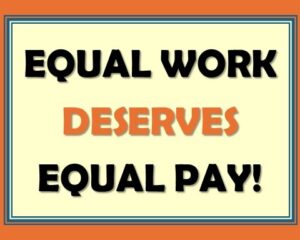World War II marked a significant turning point in the role of women in the workforce, both in the United States and around the world. Prior to the war, women were largely confined to domestic roles or certain “feminine” occupations such as teaching, nursing, and secretarial work. However, the unprecedented demand for labor during the war, combined with the absence of men who were deployed to fight, created new opportunities for women to enter industries that had been traditionally dominated by men. Yet, this period of female empowerment was short-lived, as the end of the war saw many women pushed out of their jobs to make way for returning soldiers. Since then, women have faced an uphill battle for workplace equality, especially in terms of pay and promotions.
Women’s Entry into the Workforce During WWII
 With the onset of World War II, millions of men left their jobs to serve in the military, creating a critical labor shortage in industries essential to the war effort. This included manufacturing, transportation, and agriculture—sectors that had long been male-dominated. The government and private employers launched extensive recruitment campaigns to encourage women to fill these vacancies. One of the most iconic symbols of this effort was “Rosie the Riveter,” the cultural figure representing the capable and patriotic female worker, popularized by the “We Can Do It!” poster. Women were called upon to join the workforce, not just as a matter of necessity but as a demonstration of national loyalty.
With the onset of World War II, millions of men left their jobs to serve in the military, creating a critical labor shortage in industries essential to the war effort. This included manufacturing, transportation, and agriculture—sectors that had long been male-dominated. The government and private employers launched extensive recruitment campaigns to encourage women to fill these vacancies. One of the most iconic symbols of this effort was “Rosie the Riveter,” the cultural figure representing the capable and patriotic female worker, popularized by the “We Can Do It!” poster. Women were called upon to join the workforce, not just as a matter of necessity but as a demonstration of national loyalty.
Women responded to the call in large numbers. By 1944, over 6 million women had entered the workforce in the United States alone, bringing the total number of working women to nearly 20 million. Many women took on roles in factories, producing munitions, aircraft, and other wartime materials. Women also stepped into clerical, agricultural, and service jobs that had been left vacant by men. For the first time, women were proving that they could excel in jobs traditionally reserved for men, and many discovered a newfound sense of independence and identity through their work.
The Post-War Pushback
However, when World War II ended in 1945, a wave of returning soldiers flooded back into the labor market, and the government and employers encouraged women to return to their traditional domestic roles. The message was clear: men should be prioritized in the workforce, and women were expected to vacate the jobs they had filled during the war. Industries that had previously welcomed women were now reluctant to retain them in significant numbers. Factory jobs were especially targeted for male employment, as the idea of women working in such environments was viewed as temporary and abnormal.
Despite the fact that many women enjoyed their new responsibilities and independence, the post-war era brought widespread dismissals. In some cases, women were outright fired; in others, they were pressured to resign. Women who remained in the workforce were often demoted to lower-paying, less skilled jobs. This process of pushing women out of the workforce was reinforced by cultural narratives that emphasized traditional gender roles. Popular media of the time reinforced the notion that a woman’s primary duty was to her family, and economic and social pressures worked together to reinforce the idea that the “natural” order had been restored.
The Long Struggle for Equal Pay and Opportunities
The end of World War II marked a regression in women’s economic empowerment, but it also planted the seeds for future feminist movements. While many women were displaced from the workforce, others continued working out of necessity or choice, and their presence in the labor market became more normalized in the post-war years. However, the fight for workplace equality—especially equal pay and promotions—has been an enduring struggle ever since.
In the decades following the war, women consistently earned lower wages than men for doing the same work. The gender pay gap was pervasive across industries and job categories, with women earning only a fraction of what their male counterparts were paid. This disparity was justified by societal assumptions that men were the primary breadwinners, while women were viewed as earning “supplementary” income. Furthermore, the types of jobs available to women were often lower-paying and offered limited opportunities for advancement.
The fight for equal pay became a central issue in the feminist movement of the 1960s and 1970s. With the rise of second-wave feminism, activists began advocating for legislative and social changes that would help women achieve workplace equality. One of the most significant legislative milestones was the passage of the Equal Pay Act of 1963, which made it illegal to pay women less than men for the same work. However, the implementation of this law has been uneven, and the gender pay gap persists today, although it has narrowed.
 In addition to pay disparities, women have faced barriers to promotions and leadership positions. After World War II, women were often funneled into clerical or support roles, even if they had the skills and qualifications to take on leadership responsibilities. The “glass ceiling” phenomenon—where women face invisible barriers to advancement—has been a persistent problem in many industries. Even today, women are underrepresented in executive and managerial positions, particularly in traditionally male-dominated fields like finance, technology, and manufacturing.
In addition to pay disparities, women have faced barriers to promotions and leadership positions. After World War II, women were often funneled into clerical or support roles, even if they had the skills and qualifications to take on leadership responsibilities. The “glass ceiling” phenomenon—where women face invisible barriers to advancement—has been a persistent problem in many industries. Even today, women are underrepresented in executive and managerial positions, particularly in traditionally male-dominated fields like finance, technology, and manufacturing.
The Continuing Gender Pay Gap
Despite decades of activism and legal reforms, the gender pay gap remains a pressing issue in the workforce. According to data from the U.S. Census Bureau, women earned about 82 cents for every dollar earned by men in 2022, with the gap even wider for women of color. Various factors contribute to this disparity, including occupational segregation (where women are concentrated in lower-paying fields), the motherhood penalty (where women’s earnings decrease after they have children), and discrimination.
Conclusion
The story of women in the workforce during and after World War II is one of both triumph and struggle. While the war opened the door to new opportunities and challenged traditional gender roles, the post-war era saw a backlash that pushed many women out of the workforce. Since then, women have fought tirelessly for equality in pay and promotions, but the journey has been long and fraught with challenges. Though progress has been made, the gender pay gap and barriers to advancement remain persistent issues that continue to shape the economic realities of women today. The lessons of World War II remind us that while progress can be made, it is often hard-won and must be continually defended. Women’s contributions to the workforce are indispensable, and the fight for workplace equality is far from over.
ABOUT ELLEN:
Ellen Butler is the international bestselling author of the Karina Cardinal mystery series. Her experiences working on Capitol Hill and at a medical association in Washington, D.C. inspired the mystery-action series. Publishers Weekly called the Karina Cardinal mysteries, “intelligent escapism” and InD’Tale magazine said, “unputdownable adventures that will take readers on an electrifying yet light-hearted and humorous journey.” Butler also writes historical spy fiction. The Brass Compass has won multiple awards for historical fiction including: a Speak Up Talk Radio Firebird Book Award, Indie Reader Discovery Award, and a Readers’ Favorite Silver Medal. The second book in the duology, Operation Blackbird: A Cold War Spy Novel, is inspired by true events, and won a Next Generation Indie Book Award gold medal for historical fiction. Reviewers are calling it “riveting,” and “a thrilling adventure.”
You can find Ellen at:
Website ~ www.EllenButler.net
Facebook ~ www.facebook.com/EllenButlerBooks
Instagram~ https://www.instagram.com/ebutlerbooks/
Bookbub~ https://www.bookbub.com/profile/ellen-butler
Goodreads ~ www.goodreads.com/EllenButlerBooks
Here’s a look at Ellen’s newest release Ink & Intrigue at Ivy Tree Inn
 Stumbling across a dead body could be the making … or breaking of an aspiring reporter.
Stumbling across a dead body could be the making … or breaking of an aspiring reporter.
During 1958, the workforce is predominantly male, and societal norms dictate women should be compliant, fashionable housewives. To Ariadne Winter, the sole tradition she aims to embrace is that of being fashionable. Amidst the ambiance of Ivy Tree Inn, where she’s been dispatched as a writer for Ladies’ Lifestyle Magazine, her focus wavers as she grapples with an interview assignment concerning a Hollywood starlet on the cusp of royal matrimony—an event hailed as the “Wedding of the Century.” While Ariadne dutifully attends to her task, her heart yearns for the pursuit of her collegiate ambition: to be an investigative reporter for a renowned newspaper.
However, fate intervenes when she discovers a dead body and recognizes the opportunity it presents to write her way into the role she desires. Yet, as Ariadne delves deeper into the lives of the inn’s inhabitants, she uncovers a labyrinth of intertwined relationships and long-buried secrets among guests and staff alike, yielding a plethora of suspects. With a murderer on the loose, her magazine deadline looming, and the inn cordoned off by authorities, Ariadne faces a race against time to untangle the web of deceit and solve the murder before she loses more than just her job.
Amazon: https://amzn.to/4cdBcwB
B&N: https://www.barnesandnoble.com/w/ink-and-intrigue-at-ivy-tree-inn-ellen-butler/1146066667
Kobo: https://www.kobo.com/us/en/ebook/ink-and-intrigue-at-ivy-tree-inn
Apple: https://books.apple.com/us/book/ink-and-intrigue-at-ivy-tree-inn/id6584513659






